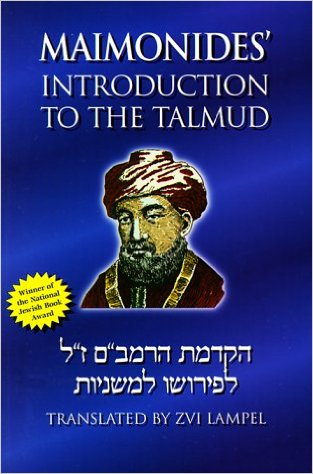
Maimonides’ Introduction to the Talmud
Translator: Zvi Lampel
Publisher: The Judaica Press, Inc.
Year: 1998
Pages: 183 plus addendums
Maimonides’ Introduction to the Talmud is the attempt by Rambam to give a precise introduction to the Talmud for the non-scholar. The book is short but is packed with large amounts of information.
Since the Talmud is based upon the Written and Oral Torah Maimonides begins by showing how both the Written Torah and the Oral Torah originated. He also explains how the Torah – both Written and Oral – were transmitted down the generations from the time of Moshe Rabbenu (Moses Our Teacher). Rambam then goes into detail regarding who a true prophet is and what prophecy is within the Jewish context. Rambam explains that this is important for the study of Talmud since Yeshoshua (Joshua) and many who followed him were themselves prophets. However, prophecy is not one of the means by which halakhah was determined. Rambam felt that it was important to understand prophecy even though it did not affect halakhic decision-making but prophets could at times temporarily suspend halakhah for very specific reasons and under very specific circumstances.
Rambam then goes on to speak further about the transmission of the Oral Torah. He goes on to explain in detail how the decision was made by Yehuda HaNasi (Judah the Prince) to write down the Mishnah (Oral Torah) in order to preserve it during a time of oppression and ultimate exile. Rambam impresses upon the reader that the Mishnah was in fact the Oral Torah that was handed down from Moshe Rabbenu who received it at Har Sinai. Rambam goes on to list the thirty halakhah that were actually given to Moshe Rabbenu. He then goes on to explain why there were additions added – the arguments and discussions among the Sages regarding the halakhah that was handed down from Moshe Rabbenu. In addition, Rambam spends some time also explaining the rise of traditions and practices which ultimately became obligatory. Rambam goes on to explain each seder of the Talmud – what each contains and why Yehuda HaNasi wrote the Mishnah in a particular order.
Rambam goes on to explain why Yehuda HaNasi’s talmidim (disciples/students) went on to also add Tosefta (written explanations) and Braitot (external teachings). Rambam explains that each of these was written with the intention of further elucidation upon the Mishnah. These writing eventually led to the writing of the Gemora which is a compilation of all the legal opinions developed from – and based upon – the Mishnah. Rambam goes on to explain the acceptance of the Gemora.
Rambam explains the authority of the Talmud with the stress upon the fact that all succeeding authorities and works accepted the Talmud as axiomatic. The works that came after the Talmud were not meant as replacements or in any way subjugation of the Talmud but were simply trying to understand the Talmud. Rambam then goes on to explain his own reasoning for attempting to write his own commentaries on the Talmud.
Anyone interested in a brief overview of what the Talmud is and how it came to be such an important part of the Jewish world would find this book to be of interest.
